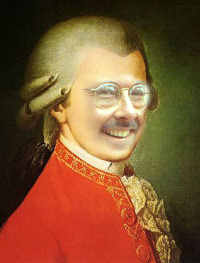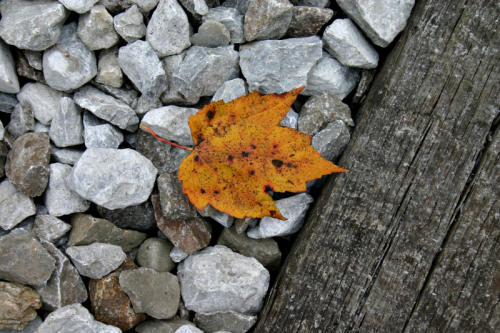A 365-Day Project
"We Are All Mozart"
A project to create
new works and change
the perception of the
music of our time.


 September 24, 2006
September 24, 2006 
It was a very pleasant weekend -- warm, breezy weather without frost, sprays of occasional thin rain, and the first day shorter than night since winter began to relent. There won't be colors to speak of this fall because (with hey, ho) the wind and the rain have already pummeled so many leaves to the ground. No one really knows what causes the brilliance of fall colors (frost and sap and warmth in the right combination), but it looks like a quiet visual run stretches ahead into brown October, grey November, white December, blue January.
Watching the sweetly unbearable complexity of the colors and shapes of autumn trees in the wind had me thinking about music by way of Jackson Pollock. In the ninth grade (that would be 1963), our class from suburban New Jersey had the opportunity to visit the Metropolitan Museum of Art in New York. There is one solitary painting that was made vivid and forever in this adolescent's mind -- "Autumn Rhythm (Number 30)".
The painting was transformational. It showed nothing but itself, paint on canvas. It didn't show autumn, it wasn't "like" autumn. Not chill, not swooping. It was ... some thing. Some vast thing, nine feet high and seventeen feet long, thick with rivers of black and white and brown. It didn't ask to be understood or even to be felt. It didn't ask anything but attention to its presence. No, not to its presence -- that sounds too psychologically territorial -- to the simple fact of its existence. No words such as those came to mind then, just a sense of having ... to ... stand ... there ... and ... look ... and ... look ... and ... look ... and ... not ... move ... feet ... rooting. Ambient sounds and voices faded away, like the moment of quiescent silence before sleep settles and the noisy dreams and terrors arrive. Those human beings shuffling by in front of me faded to transparent specters falling through the floor until that painting, that one painting, reached around me and became, no, just was the entire universe, known and yet to be known.
I cannot analyze that moment, but I can still feel it. The moment was like the transforming experiences of music, a pivot-point of existence with a tiny weight of no more than a grain pulling one side down and making clear that the direction had changed to this way, not that one.
And so it is at the heart of answering the prosaic question of why music as art differs from music as commerce. There is only one moment of transformation, one pivot-point, that belongs to a work of art. The experience is recallable but not renewable, unless it provides its own dementia. (You know I don't like writing this way. But it has to be captured before it escapes.) There is only one first bite of orange, first smell of peppermint, first feel of damp soil, first cut to the bone, first ride bareback, first sight of the Milky Way in the countryside, first sweat of sex, and probably first reach into the last moment of life.
The truth of art is always that first moment. That is why we hate art as much as we love it. It confronts us with a vision that we have not ourselves owned, and it is taken by us, and when it is taken and we have it, we know what we have not known before. And then it is gone; we can never be with that art again in the same way. We love it now for being what we know, but hate it for never being enough. (It explains why musicians always want more from Mozart, even to the point of pressing themselves through its sieve.) And because the truth of art in that moment can be discovered but once, we search for more moments like that we had experienced, and cannot find them. The new first moments are not what we expect, and so they repel us. The collection of those moments that we call age, or wisdom on good days, gathers in the hallways of our mind. We fall over them on the way to the door to let in the new experience. We bloody ourselves and blame the visitor. Or we arrive at the door to find the moment has vanished. Unready, we also blame the visitor. We lose courage, if we ever had it. Cynicism cauterizes the transcendent wounds of art. We turn around, older.
By contrast, commerce is our companion. We can buy experiences wholesale. Our desperate isolation is relieved by the commonality of others' approbation. We laugh with the laugh track, scream with the dimished chord, wring our hands with the dark shadows opposite which stood enervated film crews awaiting the seventeenth take and then lunch from the cart. It is dependable. We relive our vinyl rebellion in polycarbonate and then in silicon, asking our shriveling heroes to bestow relevance, all plus shipping & handling.
And so, looking at the whipping wind made manifest in the trees I wonder, why do we need to make it interesting? What is the drive? Who cares? What is the measure? Jackson Pollock or George Lucas? John Cage or John Williams? Jennifer Higdon or Jennifer Love Hewitt? No, not even such mundane questions. Just this: what is first, what is memorable? So much as the eyes can see, these are the same leaves that fell last year and the year before and the century before that. Can this experience be purchased? Is there an Imax of autumnal ecstasy?
As a composer, I may try to capture that first moment and set it down, but I am damned because the transformation passes. Then the skill and intellect must decide if others will be transformed by that moment despite my ennui. Oh, yes. This is why I do not trust the intuitive composer, working from pitch to pitch in a rush of romantic passion and pathos. There is too much craft to cradling this butterfly of discovery without injuring it so it can be let go and fly to others. It is not mere cleverness that decides to mutate a sound or decide upon a modulation. It is a sense of credibility, a commitment to human association, and an intimate knowledge of tiny mechanisms, of loneliness (a leaf falls), of grains resting on one side -- or is it the other? -- of a pivot-point. This way!
